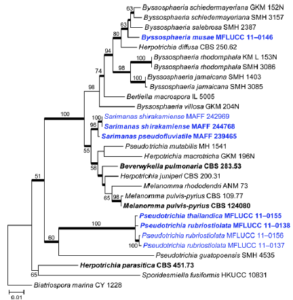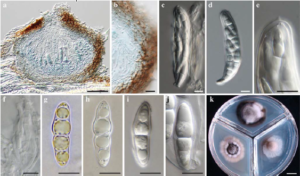Sarimanas pseudofluviatile Matsumura, K. Hiray. & Kaz. Tanaka.
Index Fungorum number: IF551053, Facesoffungi number: FoF00498; Fig. 2
Etymology – In reference to the ascospore similarity of the taxon to Massarina fluviatilis (= Lentithecium fluviatile).
Holotype – HHUF 27552.
Saprobic on dead wood. Sexual morph Ascomata 140 – 220 μm high, 180 – 320 μm diam., globose to subglobose, covered with sparse hyphae, ostiolate. Neck 37 – 50 μm long, 50 – 75 μm wide. Peridium in surface view textura prismatica, in longitudinal section 20 – 35 μm thick at sides, composed of 4 – 6 layers of polygonal, hyaline to brown, 5 – 13 × 5 – 8 μm cells. Hamathecium 1.5 – 2.5 μm wide, septate. Asci 90 – 110 × 18 – 23.5 μm (x̄ = 99 × 20.2 μm, n = 30), fissitunicate, cylindrical, short pedicellate (5 – 15 μm long; x̄ = 8.8 μm, n = 19), apically rounded with a shallow ocular chamber. Ascospores (27–) 28.5 –33(–36) × (7–) 8 – 10 μm (x̄ = 30.6 × 8.7 μm, n = 100), L/W (3–)3.2 – 3.9(–4.1) (x̄ = 3.5, n = 100), broadly fusiform to ellipsoidal with rounded ends, with a septum submedian (0.51 – 0.55, x̄ = 0.53, n = 85), hyaline, smooth-walled, with an entire sheath of 2–5μm wide. Asexual morph Undetermined.
Culture characters – On RSA, numerous ascomata are formed on the surface of rice straw and the ascospores are similar to those found in nature, measuring 28.5 – 33 × 8.5 – 10 μm (x̄ = 30.7 × 9.3 μm, n = 30). No asexual morph is formed.
Materials examined – JAPAN, Hokkaido, Sapporo Toyohira-river, riverbank, on dead twigs of woody plant, 2 September 2001, K. Tanaka, KT 760 (= HHUF 27552, holotype designated here); ex-type living culture=MAFF 239465. GenBank ITS: LC001717; LSU: LC001714; SSU: LC001711; ibid., KT 759 (= HHUF 27551, paratype).
Notes – This species was reported as Massarina fluviatilis by Tanaka and Harada (2003c), but this was obviously a misidentification. We examined the holotype of M. fluviatilis (Van Ryckegem 509 in GENT; Van Ryckegem and Aptroot 2001) and found that M. fluviatilis on Phragmites australis (Poaceae) has ascomata composed of thick-walled, slightly larger cells (5 – 30 × 2.5 – 11 μm) when compared to those of S.pseudofluviatile on woody plants. The ascospores of M.fluviatilis are 1 – 3 -septate in sequence 2 : 1 : 3, but those are consistently 1-septate in S. pseudofluviatile. Zhang et al. (2009b) established a new genus Lentithecium using M. fluviatilis as the type species, and later placed the genus in Lentitheciaceae (Zhang et al. 2009a). In a phylogenetic analysis, S.pseudofluviatile deviated from Lentitheciaceae and clustered in the clade of Melanommataceae together with S.shirakamiense (Fig. 1).

Fig. 1 Phylogram generated from Maximum likelihood (RAxML) analysis based on combined LSU, SSU and TEF1 sequence data of Melannomataceae. Maximum likelihood bootstrap support values greater than 50 % are indicated above or below the nodes, and branches with Bayesian posterior probabilities greater than 0.95 are given in bold. The ex-types (reference strains) are in bold; the new isolates are in blue. The tree is rooted with Biatriospora marina strain CY 1228.

Fig. 2 Sarimanas pseudofluviatile (holotype) a Ascoma in longitudinal section b Peridium c, d Asci e Ascus apex f Pseudoparaphyses g–j Ascospores k Colonies on PDA (upper), MEA (left), and CMA (right) after 30 d at 20 °C in the dark. a – j from HHUF 27552 (holotype); k from MAFF 239465 (ex-type). Scale bars: a = 100 μm, b, c – j = 10 μm, k = 1 cm.
